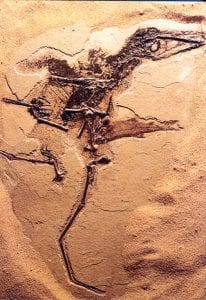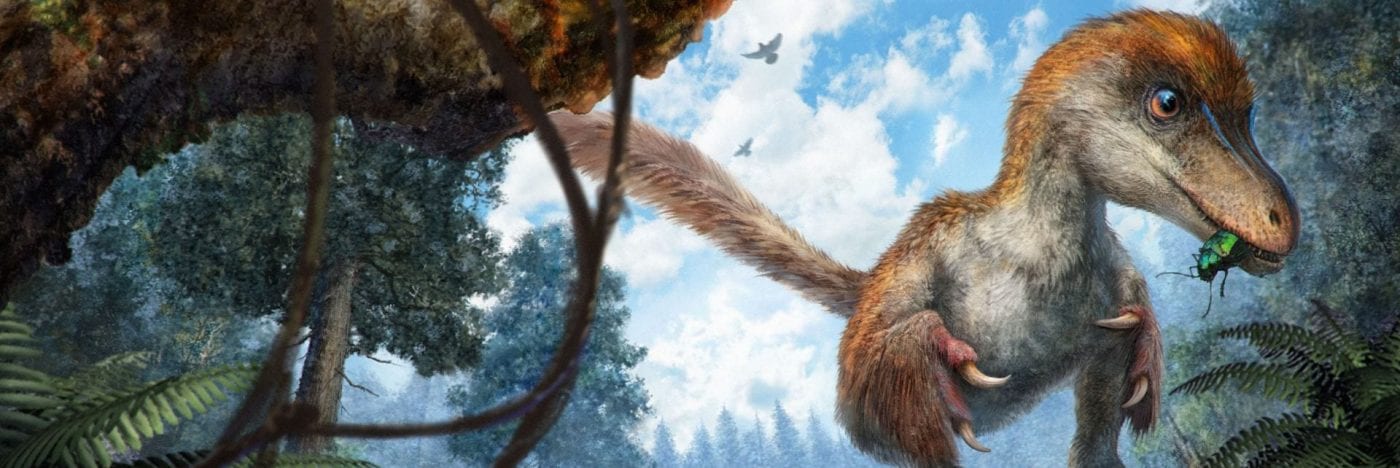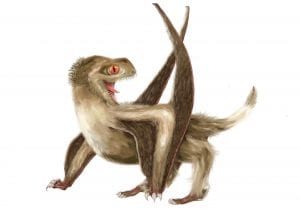Pycnofibres
 The first fossil epidermal structures were identified in some exceptionally preserved pterosaur specimens as long ago as 1831 (Goldfuss 1831). This first record was in a specimen of Scaphognathus, and later stitch-like pits were described in a specimen of Rhamphorhynchus (Wanderer 1908), which were later interpreted as remnants of a covering of hair (Wiman 1925). Hair- or fur-like structures were subsequently reported in specimens of the pterosaurs Anurognathus, Pterodactylus, Dorygnathus and Pterodactylus, most of which were from the Upper Jurassic Solnhofen Limestone of southern Germany, the source of the famous specimens of the ‘first bird’ Archaeopteryx with its feathers. As the pterosaur fluff was preserved as external moulds, these fossils were often challenged as taphonomic or even artificial products (Frey and Martill 1998).
The first fossil epidermal structures were identified in some exceptionally preserved pterosaur specimens as long ago as 1831 (Goldfuss 1831). This first record was in a specimen of Scaphognathus, and later stitch-like pits were described in a specimen of Rhamphorhynchus (Wanderer 1908), which were later interpreted as remnants of a covering of hair (Wiman 1925). Hair- or fur-like structures were subsequently reported in specimens of the pterosaurs Anurognathus, Pterodactylus, Dorygnathus and Pterodactylus, most of which were from the Upper Jurassic Solnhofen Limestone of southern Germany, the source of the famous specimens of the ‘first bird’ Archaeopteryx with its feathers. As the pterosaur fluff was preserved as external moulds, these fossils were often challenged as taphonomic or even artificial products (Frey and Martill 1998).
[Right] Bat-like pterosaurs, a reconstruction from an 1843 paper by E. Newman, showing fluff over the body.
 [Left] The pterosaur Sordes pilosus, which means ‘hairy devil’, from the Late Jurassic of Kazakhstan, showing fluff (pycnofibres) over the head and back.
[Left] The pterosaur Sordes pilosus, which means ‘hairy devil’, from the Late Jurassic of Kazakhstan, showing fluff (pycnofibres) over the head and back.
It took a long time before pterosaur fluff was noted from another locality. In the 1970s, the pterosaur Sordes was reported from the Upper Jurassic Karatau Formation of Kazakhstan bearing extensive fibres preserved as carbonaceous impressions, which were interpreted as hair-like structures (Sharov 1971). The fibres in the wing membranes were subsequently reinterpreted as decomposed actinofibrils (Unwin and Bakhurina 1994), while these in the other areas were accepted as pelage (Bakhurina and Unwin 1995).
With the discoveries of exceptionally preserved hair-like structures in several specimens belonging to Jeholopterus, Pterorhynchus, Gegepterus and an undetermined genus from the Middle-Upper Jurassic Haifanggou and Lower Cretaceous Yixian formations in NE China since the early 2000s (Wang et al., 2002, 2007; Czerkas and Ji, 2002; Lü, 2002), pterosaurs with hair-like integumentary coverings have been widely accepted. Some densely aligned pinnate fibres that formed distinct tufts in a diamond- and V-shaped pattern covering the wing were interpreted as proto-feathers (Czerkas and Ji, 2002). However, their interpretation was questioned by Kellner (2009), who named the hair-like structures pycnofibres to differentiate them from mammalian hair and avian feathers.
Pterosaurs had feathers too
Most recently, Yang et al. (2019) identified four types of pycnofibers in two anurognathid pterosaur specimens from the Middle-Late Jurassic of China: monofilaments (‘hairs’), tufted monofilaments, bunched fibres, and multiply-branching down feathers. In detail, they demonstrated that pycnofibres share key characteristics with feathers: a tube-like structure of the calamus, melanin-containing melanosomes throughout the barbs, and morphologies that include three kinds of branching structures.
These ancient and newer findings confirm that pterosaurs possessed a dense filamentous covering that likely functioned in thermoregulation, tactile sensing, signalling, and aerodynamics, and such structures are found in all main pterosaur groups. This interpretation that pterosaurs carried feathers, an innovation shared with their sister group, the dinosaurs (including birds), is likely to be controversial, but it has profound implications. There are two possible interpretations:
- The traditional view: The four dermal structures seen in pterosaurs are unique to pterosaurs, and should be called pycnofibres. True ‘feathers’ are known only birds and their closest relatives among theropod dinosaurs, and the dermal structures seen in some ornithischians and in pterosaurs evolved independently. True feathers originated about 170 million years ago (Middle Jurassic) in the clade Coelurosauria (= birds + close theropod relatives).
- The revised view: The four dermal structures seen in pterosaurs are homologous with similar structures seen in various dinosaurs and birds. True ‘feathers’ originated at the time of the common ancestor of pterosaurs and dinosaurs (including birds), and they diversified into many forms, but pennaceous feathers (= contour and flight feathers) are known only in the clade Coelurosauria (= birds + close theropod relatives). feathers originated about 250 million years ago (Early Triassic) in the clade Avemetatarsalia (= dinosaurs + pterosaurs).
Literature cited
- Bakhurina, N.N. and Unwin, D.M. 1995. A survey of pterosaurs from the Jurassic and Cretaceous of the former Soviet Union and Mongolia. Historical Biology 10, 197–245.
- Czerkas, S. A., Ji, Q. 2002. A rhamphorhynchoid with a headcrest and complex integumentary structures. In Feathered Dinosaurs and the Origin of Flight (Czerkas, S.J., ed.), pp. 15–41. The Dinosaur Museum.
- Frey, E. and Martill, D.M. 1998. Soft tissue preservation in a specimen of Pterodactylus kochi (Wagner) from the Upper Jurassic of Germany. Neues Jahrbuch für Geologie und Paläontologie, Abhandlungen 210, 421–441
- Goldfuss, A. 1831. Beiträge zur Kenntnis verschiedener Reptilien der Vorwelt. Nova Acta Leopoldina Carolinensis 15, 61–128.
- Kellner, A.W., Wang, X.L., Tischlinger, H., Campos, D.D.A., Hone, D.W.E. and Meng, X. 2010. The soft tissue of Jeholopterus (Pterosauria, Anurognathidae, Batrachognathinae) and the structure of the pterosaur wing membrane. Proceedings of the Royal Society B 277, 321–329
- Lü, J. 2002. Soft tissue in an Early Cretaceous pterosaur from Liaoning Province, China. Memoir of the Fukui Prefectural Dinosaur Museum 1, 19–28.
- Sharov, A.G. 1971. [New flying reptiles from the Mesozoic of Kazakhstan and Kirgizia] (in Russian). Trudy Academia Nauk SSSR, Palaeontologicheskogo Instituta 130, 104–113.
- Unwin, D.M. and Bakhurina, N.N. 1994. Sordes pilosus and the nature of the pterosaur flight apparatus. Nature 371, 62–64.
- Wanderer, K. 1908. Rhamphorhynchus gemmingi H. V. Meyer, ein Exemplar mit teilweise erhaltener Flughaut aus dem kgl. Mineralog. Geol. Museum zu Dresden. Palaeontographica 55, 195-216.
- Wang, X.L., Zhou, Z.H., Zhang, F.C. and Xu, X. 2002. A nearly completely articulated rhamphorhynchoid pterosaur with exceptionally well-preserved wing membranes and ‘hairs’ from Inner Mongolia, northeast China. Chinese Science Bulletin 47, 226–230.
- Wang, X.L., Kellner, A.W.A., Zhou, Z.H. and Campos, D.A. 2007. A new pterosaur (Ctenochasmatidae, Archaeopterodactyloidea) from the Lower Cretaceous Yixian Formation of China. Cretaceous Research 28, 245–260.
- Wiman, C. 1925. Über Dorygnathus und andere Flugsaurier. Bulletin of the Geological Institute, University of Uppsala 19, 23-54.
- Yang, Z.X., Jiang, B.Y., McNamara, M.E., Kearns, S.L., Pittman, M., Kaye, T.G., Orr, P.J., Xu, X., and Benton, M.J. 2019. Pterosaur integumentary structure with complex feather-like branching. Nature Ecology & Evolution 3, 24–30. pdf. Supplementary file.



